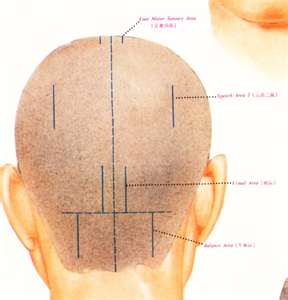

There is also some palpation to be done prior to needling. This is a very gentle form of scalp acupuncture however, it requires a lot more testing and retesting while using it. Yamamoto's book these somatotopes look like a silhouette of a man sitting on the ground reading. This style of scalp acupuncture deals with somatotopes on the scalp. The other scalp system was developed by Dr. Therefore there is similarity of MU point locations on the body to the location of the brain responsible for a specific function. This is the same sensory area we needle over if there is a sensory problem with a patient. In the back of the Central sulcus is a sensory area. This area is involved with control of voluntary muscles. If you look at the brain area where the motor line traverses the scalp it will be right on the brain's motor area just in front of the Central Sulcus.

For example the Motor Area of brain and the Motor area on the scalp correspond. As if these functions act as the MU points on the scalp. Taking this mapping correspondence of the overlaying scalp areas located near or at the brain areas that are responsible for different functions will treat problems with these brain functions. The Mu points on the body are about at the same location where the organ it is named after is located. The Huang Di Nei Jing also contributed channel information to scalp acupuncture.

This is a system which was created after analyzing the functions of MU points and channel theory. The traditional scalp acupuncture we all learned in acupuncture school comes from Jiao Shunta. Each scalp system is based on a different micro system. Scalp acupuncture is a therapy where the needles are applied to parts of the scalp to produce a healing response to a specific problem. For some unknown reason scalp acupuncture remains somewhat of a black sheep of the acupuncture world. Many times it may be a technique added to a TCM treatment to enhance the overall effect. I do not hear from practitioners about their success with patients using scalp treatments. I hear a lot about these different styles, yet scalp acupuncture is one of the least utilized styles.

Our preferences depend upon the school we attended and the main styles it taught. There is regular TCM acupuncture, Japanese acupuncture, Korean acupuncture, Auricular, Five elements, Channel balancing from Dr. There are many different techniques available to an acupuncture practitioner.


 0 kommentar(er)
0 kommentar(er)
